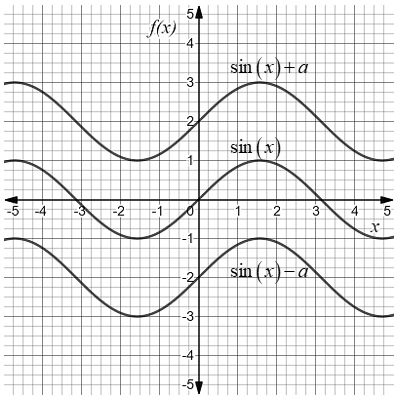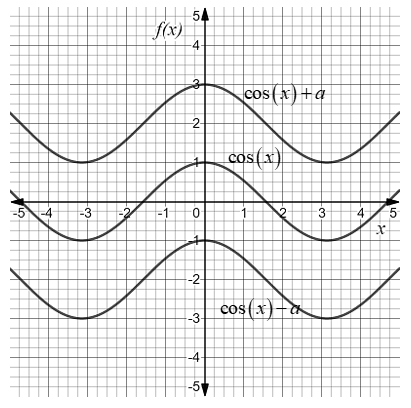
How do you identify the vertical and horizontal translations of sine and cosine from a graph and an equation?
Answer
435.6k+ views
Hint: For the function \[y = f\left( x \right)\], the vertical translation is described by the equation \[y = f\left( x \right) + a\] and horizontal translation is described by the equation \[y = f\left( {x - a} \right)\]. the vertical translation is described by the equation \[y = f\left( x \right) + a\] such that if \[a\] is greater than zero then the shift in the graph is upward from the original and if \[a\] is less than zero then the shift in the graph is downward from the original. the horizontal translation is described by the equation \[y = f\left( {x - a} \right)\] such that if \[a\] is greater than zero then the shift in the graph is toward right from the original and if \[a\] is less than zero then the shift in the graph is toward left from the original.
Complete step by step solution:
Consider the sine function as \[y = \sin x\] and the cosine function as \[y = \cos x\].
It is known that for a function \[y = f\left( x \right)\], the vertical translation is described by the equation \[y = f\left( x \right) + a\] such that if \[a\] is greater than zero then the shift in the graph is upward from the original and if \[a\] is less than zero then the shift in the graph is downward from the original.

Therefore vertical translation of a sine function is written as \[y = \sin x + a\] and the vertical translation of a cosine function is written as \[y = \cos x + a\]. Where \[a\] cannot be zero.

Thus, if we are able to write the sin function in the form \[y = \sin x + a\] and the cosine function in the form \[y = \cos x + a\] where in both cases \[a \ne 0\] then it represents vertical translation in both trigonometric functions from the original.
In the graph, if sine functions or cosine functions wave is not symmetric to \[x\]-axis then there is a vertical shift in the graph from the original.
It is known that for a function \[y = f\left( x \right)\], the horizontal translation is described by the equation \[y = f\left( {x - a} \right)\] such that if \[a\] is greater than zero then the shift in the graph is toward right from the original and if \[a\] is less than zero then the shift in the graph is toward left from the original.
Therefore horizontal translation of a sine function is written as \[y = \sin \left( {x - a} \right)\] and the horizontal translation of a cosine function is written as \[y = \cos \left( {x - a} \right)\]. Where \[a\] cannot be zero.
Thus, if we are able to write the sin function in the form \[y = \sin \left( {x - a} \right)\] and the cosine function in the form \[y = \cos \left( {x - a} \right)\] where in both cases \[a \ne 0\] then it represents horizontal translation in both trigonometric functions from the original.
In the graph, if sine functions or cosine functions wave is not symmetric to \[y\]-axis then there is a horizontal shift in the graph from the original.
Note: For horizontal shift, the function is \[y = f\left( {x - a} \right)\] and for vertical shift, the function is \[y = f\left( x \right) + a\] if the original function is \[y = f\left( x \right)\]. The horizontal translation of a sine function is written as \[y = \sin \left( {x - a} \right)\] and the horizontal translation of a cosine function is written as \[y = \cos \left( {x - a} \right)\]. Where \[a\] cannot be zero. The vertical translation of a sine function is written as \[y = \sin x + a\] and the vertical translation of a cosine function is written as \[y = \cos x + a\]. Where \[a\] cannot be zero.
Complete step by step solution:
Consider the sine function as \[y = \sin x\] and the cosine function as \[y = \cos x\].
It is known that for a function \[y = f\left( x \right)\], the vertical translation is described by the equation \[y = f\left( x \right) + a\] such that if \[a\] is greater than zero then the shift in the graph is upward from the original and if \[a\] is less than zero then the shift in the graph is downward from the original.

Therefore vertical translation of a sine function is written as \[y = \sin x + a\] and the vertical translation of a cosine function is written as \[y = \cos x + a\]. Where \[a\] cannot be zero.

Thus, if we are able to write the sin function in the form \[y = \sin x + a\] and the cosine function in the form \[y = \cos x + a\] where in both cases \[a \ne 0\] then it represents vertical translation in both trigonometric functions from the original.
In the graph, if sine functions or cosine functions wave is not symmetric to \[x\]-axis then there is a vertical shift in the graph from the original.
It is known that for a function \[y = f\left( x \right)\], the horizontal translation is described by the equation \[y = f\left( {x - a} \right)\] such that if \[a\] is greater than zero then the shift in the graph is toward right from the original and if \[a\] is less than zero then the shift in the graph is toward left from the original.
Therefore horizontal translation of a sine function is written as \[y = \sin \left( {x - a} \right)\] and the horizontal translation of a cosine function is written as \[y = \cos \left( {x - a} \right)\]. Where \[a\] cannot be zero.
Thus, if we are able to write the sin function in the form \[y = \sin \left( {x - a} \right)\] and the cosine function in the form \[y = \cos \left( {x - a} \right)\] where in both cases \[a \ne 0\] then it represents horizontal translation in both trigonometric functions from the original.
In the graph, if sine functions or cosine functions wave is not symmetric to \[y\]-axis then there is a horizontal shift in the graph from the original.
Note: For horizontal shift, the function is \[y = f\left( {x - a} \right)\] and for vertical shift, the function is \[y = f\left( x \right) + a\] if the original function is \[y = f\left( x \right)\]. The horizontal translation of a sine function is written as \[y = \sin \left( {x - a} \right)\] and the horizontal translation of a cosine function is written as \[y = \cos \left( {x - a} \right)\]. Where \[a\] cannot be zero. The vertical translation of a sine function is written as \[y = \sin x + a\] and the vertical translation of a cosine function is written as \[y = \cos x + a\]. Where \[a\] cannot be zero.
Recently Updated Pages
The correct geometry and hybridization for XeF4 are class 11 chemistry CBSE

Water softening by Clarks process uses ACalcium bicarbonate class 11 chemistry CBSE

With reference to graphite and diamond which of the class 11 chemistry CBSE

A certain household has consumed 250 units of energy class 11 physics CBSE

The lightest metal known is A beryllium B lithium C class 11 chemistry CBSE

What is the formula mass of the iodine molecule class 11 chemistry CBSE

Trending doubts
Why was the Vernacular Press Act passed by British class 11 social science CBSE

Arrange Water ethanol and phenol in increasing order class 11 chemistry CBSE

Name the nuclear plant located in Uttar Pradesh class 11 social science CBSE

What steps did the French revolutionaries take to create class 11 social science CBSE

How did silk routes link the world Explain with three class 11 social science CBSE

What are the various challenges faced by political class 11 social science CBSE




